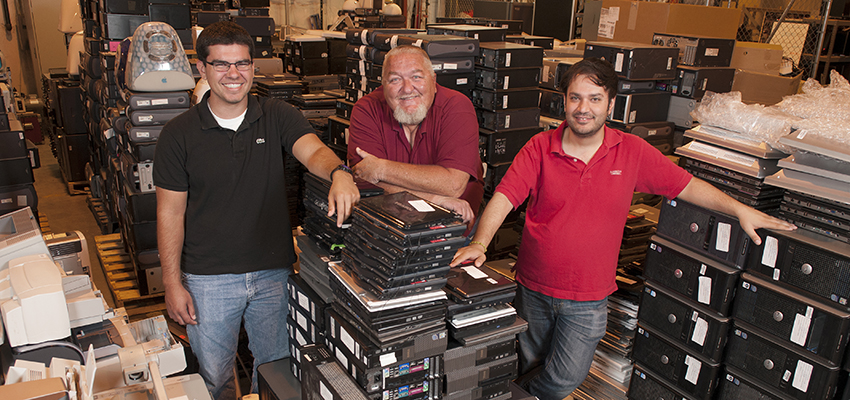There’s a lot of high-tech equipment in the back of this Illinois State warehouse in north Normal—stuff with cool names like the Degausser and KillDisk—but the most impressive sight is a simple dry erase board.
That’s how the team in charge of Illinois State’s revamped tech recycling program keeps score. Since July alone, they’ve kept 5,000 pounds of computer equipment out of landfills and saved the University more than $323,000—big numbers that the team updates every month on their whiteboard.
“This is extremely rewarding to see, that not everything needs to be tossed away,” said Bart Lytel from Illinois State’s Administrative Technologies (AT) unit, who supervises the eRecycling program.
But on top of the environmental impact and financial savings, the innovative program offers a unique real-world learning opportunity to the students who helped build it from scratch, Christopher Hinds and Bruno Raoufi. When Hinds first arrived at the Property Control warehouse in summer 2012, the program didn’t really exist. He had to go through 600 computers the first week just to clear himself a workspace.
Previous to their arrival, the program’s focus was mostly on data protection; as old computers arrived at Property Control, they’d drill holes in the hard drives, then send the rest off to Springfield for recycling.
But there was a push to reboot the program, Lytel said, as a way to rebuild computers discarded by campus units buying new equipment, and returning those “recycled” machines to campus—free of charge. Since July 1, they’ve returned 394 units (a machine or monitor) back to campus, good as new.
“Being tech guys, we’re always looking for ways to use what we got,” Lytel told STATEside. “We don’t always get all the new parts and pieces.”
So Hinds (and later Raoufi) got to work. They set up initial procedures for the program, did some documentation, and worked with real clients from campus. By the time Lytel was assigned to the new-look program this past July, they “had already laid a pretty good foundation for what we wanted to do,” Lytel said. They also sped up processing times; recent upgrades allow them to wipe around 90 hard drives a day using the KillDisk software, up from 12 drives per day.
Hinds was the catalyst. The senior entrepreneurship and small business management and organizational leadership double major has always been interested in electronics, thanks to his family’s tech background. He says his eRecycling experience was good preparation for his career plans in business consulting.
“I was able to dip my feet into a whole bunch of different aspects of trying to figure out what this organization was going to do,” said Hinds, who’s worked for AT since 2011.
There are a lot of different possible fates for a computer that lands with Lytel’s crew. If it’s a police computer with sensitive data on the hard drive, for example, they can make it permanently unusable with the Degausser—basically a giant magnet that sucks all the data off the drive and destroys it. But they can also fully wipe a drive using KillDisk, or put new drives into empty computer shells.
A big part of their work is building machines from scratch using parts from multiple older computers, said Raoufi, a junior computer science major with a minor in mathematics and business administration. Raoufi wants to work in servers and networking after graduation, and he says his eRecycling experience is a good complement to what he learns in the classroom.
“Inside a computer, it never looks like any of the diagrams they show you in a PowerPoint presentation,” said Raoufi. “You can actually see it here (in eRecycling).”
Lytel said their rehabbed machines are often used by graduate assistants or student workers who need good computers but whose campus units struggle to pay for them. University Galleries in the College of Fine Arts recently received computers that allow its unpaid student interns to conduct their research and gather data—work that wouldn’t have been possible otherwise, said Director Barry Blinderman.
University Galleries also needs far more computers than what it’s able to purchase every three years or so with its budget, said Blinderman.
“We include more and more video and computer artworks in our exhibits, and the iMacs and Mac minis we have received from the rehab program work splendidly for this purpose,” he said.
By the end of this year, the eRecycling team looks to reach two benchmarks—8,000 pounds of equipment kept out of landfills, and $500,000 saved by the University, Lytel said. The program is a good example, Lytel said, of how campus leaders prioritize sustainability and make the most of existing resources.
“Wouldn’t it be amazing if this campus could be the flagship for the rest of the state on how to recycle and reuse electronic equipment?” he said. “I think that’s very doable.”
Ryan Denham can be reached at rmdenha@IllinoisState.edu.



